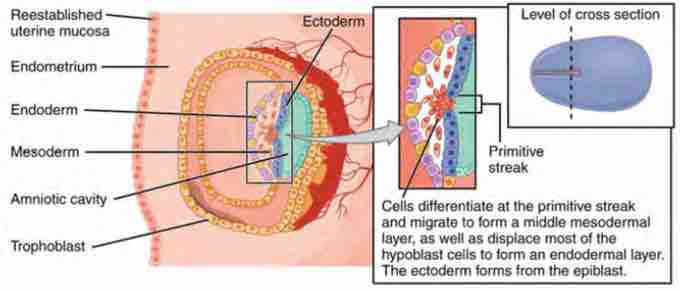Gastrulation is a phase early in the embryonic development of most animals during which the single-layered blastula is reorganized into a trilaminar (three-layered) structure known as the gastrula. These three germ layers are known as the ectoderm, mesoderm, and endoderm.

Gastrulation
Formation of the three primary germ layers occurs during the first two weeks of development. The embryo at this stage is only a few millimeters in length.
Gastrulation takes place after cleavage and the formation of the blastula and the primitive streak. It is followed by organogenesis, when individual organs develop within the newly-formed germ layers. Each layer gives rise to specific tissues and organs in the developing embryo.
In amniotes such as humans, gastrulation occurs in the following sequence:
- The embryo becomes asymmetric.
- The primitive streak forms.
- Cells from the epiblast at the primitive streak undergo an epithelial to mesenchymal transition and ingress at the primitive streak to form the germ layers.
The ectoderm gives rise to the epidermis, and also to the neural crest and other tissues that will later form the nervous system. The mesoderm is found between the ectoderm and the endoderm, giving rise to somites.
The somites form muscle, the cartilage of the ribs and vertebrae, the dermis, the notochord, blood and blood vessels, bone, and connective tissue.
The endoderm gives rise to the epithelium of the digestive and respiratory systems, and the organs associated with the digestive system, such as the liver and pancreas. Following gastrulation, the cells in the body are either organized into sheets of connected cells (as in epithelia), or as a mesh of isolated cells, such as mesenchyme.
The molecular mechanism and timing of gastrulation is different in different organisms. However, some common features of gastrulation across triploblastic organisms include:
- A change in the topological structure of the embryo, from a simply connected surface (sphere-like), to a non-simply connected surface (torus-like)
- The differentiation of cells into one of three types (endodermal, mesodermal, or ectodermal).
- The digestive function of a large number of endodermal cells.
Although gastrulation patterns exhibit enormous variation throughout the animal kingdom, they are unified by the five basic types of cell movements that occur during gastrulation:
- Invagination
- Involution
- ingression
- Delamination
- Epiboly